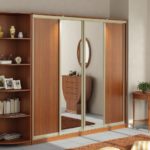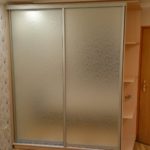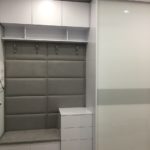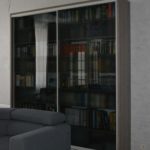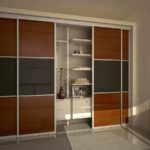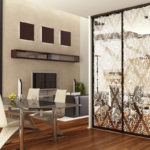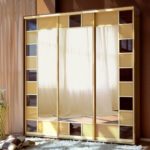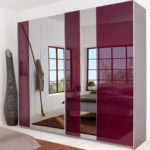Interesting examples of the design of wardrobes
Sliding wardrobes in the interior of any room are an ergonomic, beautiful and functional solution. Their designs are so versatile that it's easy to find a model that fits perfectly into any space. Whether it is rustic, neoclassical, hi-tech or eclectic - the wardrobe can be made in the style corresponding to the interior in order to blend in perfectly with the overall harmony.

Features of the wardrobe
The main feature of sliding wardrobes, which distinguishes them from ordinary wardrobes with hinged doors, is a convenient sliding system, which has a number of advantages:
- Substantial space savings (swing doors require additional opening space).
- High safety (you can get injured about the corner of an open cabinet door if you bump into it in the dark).
- Adjustable: If the system becomes unbalanced after a long period of use, all of its components can be adjusted independently.
- Less effort to open, which is important for people with disabilities and the elderly.

Additional Information! Other features of sliding-door wardrobes are the possibility of developing an individual design and filling, as well as embedding: the back wall of the cabinet can be a wall, the bottom can be the floor, and the upper part can be the ceiling.

Types of wardrobes
By the type of installation, sliding-door wardrobes are divided into built-in, semi-built and cabinet. The pros and cons of each of these varieties are determined by the goals of the consumer. For example, the structural integrity of the cabinet cabinet will be a plus for those who often make rearrangements, and a minus for those who seek to save as much space in the room as possible.
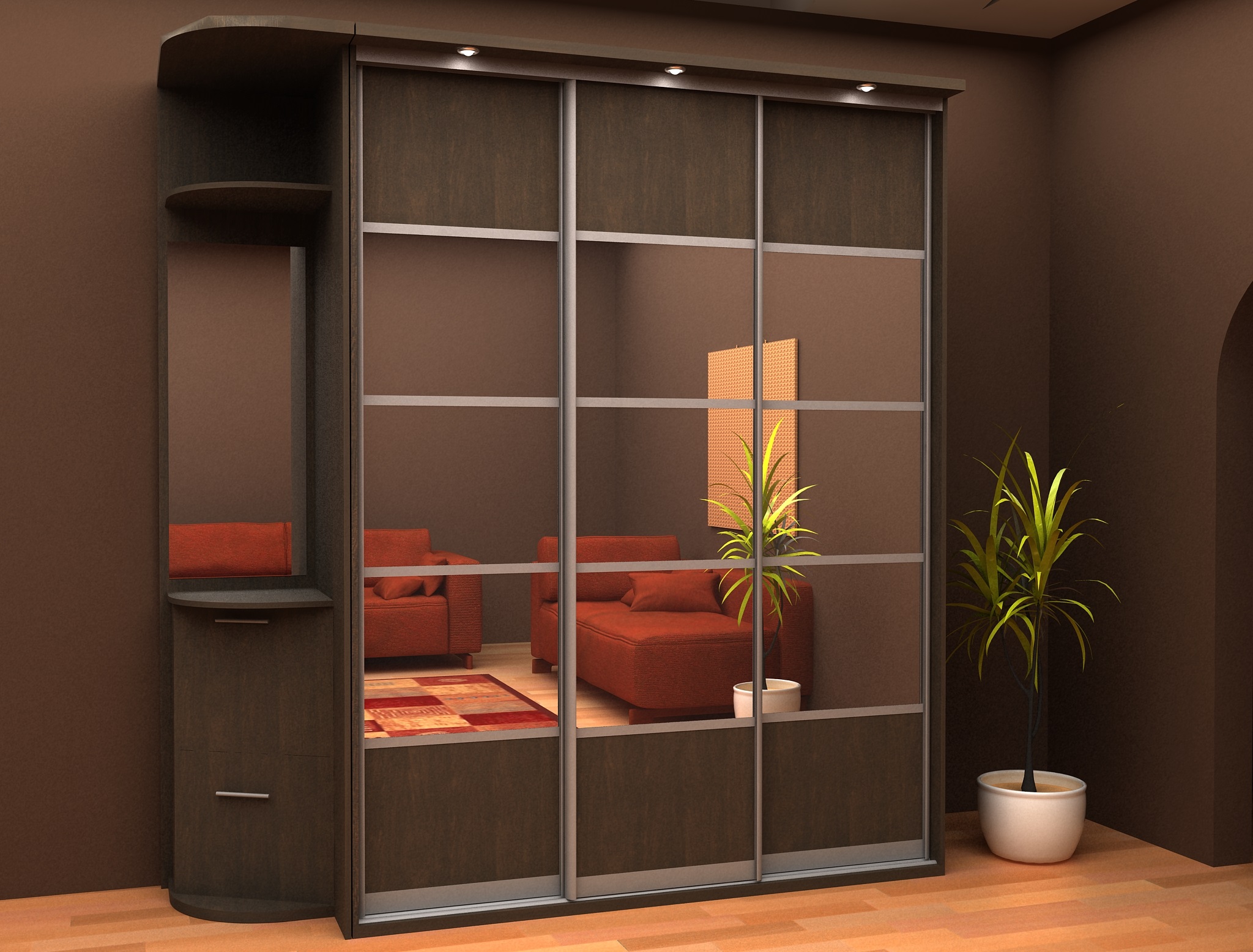
In shape, wardrobes, in addition to straight lines located along the wall, are angular, triangular, radius, pentagonal and trapezoidal. In fact, modern models can be of any shape that does not violate the laws of physics. The choice of shape may depend on individual preferences and on the conditions dictated by the layout of the room (non-standard corners, sloped ceiling).

Also, sliding wardrobes can differ in the type of door fastening:
- Hinged doors: fastened with rollers under the top of the cabinet (the most popular and least secure type of fastening).
- Framed doors: the most reliable doors, equipped with a metal frame that provides structural rigidity.
- Cover profile doors: robust yet heavy construction supported by rollers at the bottom of the cabinet.
- Coplanar doors: a frameless mechanism that allows doors to move in the same plane without overlapping.
Freestanding
Cabinet, or free-standing, sliding wardrobes differ in that they have all walls, and they can be easily moved. They do not require complex dismantling when moving or repairing.For installation in a rented apartment, a free-standing cabinet is often the only possible solution, since it does not have to damage the wall during installation.

Note! Another advantage of cabinet cabinets is the ability to use them for zoning open-plan rooms. That is, the cabinet can be placed with its end against the wall so that it performs a double function: its back will act as a wall.

Built-in
Built-in wardrobes are the most ergonomic option: taking up a minimum of space, the wardrobe does not lose functionality and spaciousness. Also, built-in cabinets are much cheaper than cabinet ones, since less material is required for their production. Depending on the type of installation, the cabinet may not need a back wall, sides or roof.

Additional Information! The main types of built-in wardrobes are corner ones, built into a niche and built into the entire length of the wall.
Corner cabinets can be L-shaped, trapezoidal, radius or triangular. Different shapes of built-in wardrobes can play different roles in the interior: be the main accent of the room, hide the unevenness of the walls, create a single ensemble with other pieces of furniture.
DIY wardrobe
The sliding wardrobe can be designed and assembled by yourself. For those who have skills in furniture design, this can be a way to significantly save money and customize the wardrobe to their individual needs, having thought over every nuance of the internal filling and aesthetic characteristics.

Drawing
The first thing to do is draw up a drawing. At this stage, accurate (up to 3 mm) measurements of the niche or other area where the cabinet will be placed must be carried out. The general layout of the cabinet should also be thought out: type, size, number of doors, internal sections, modules and filling components in them.
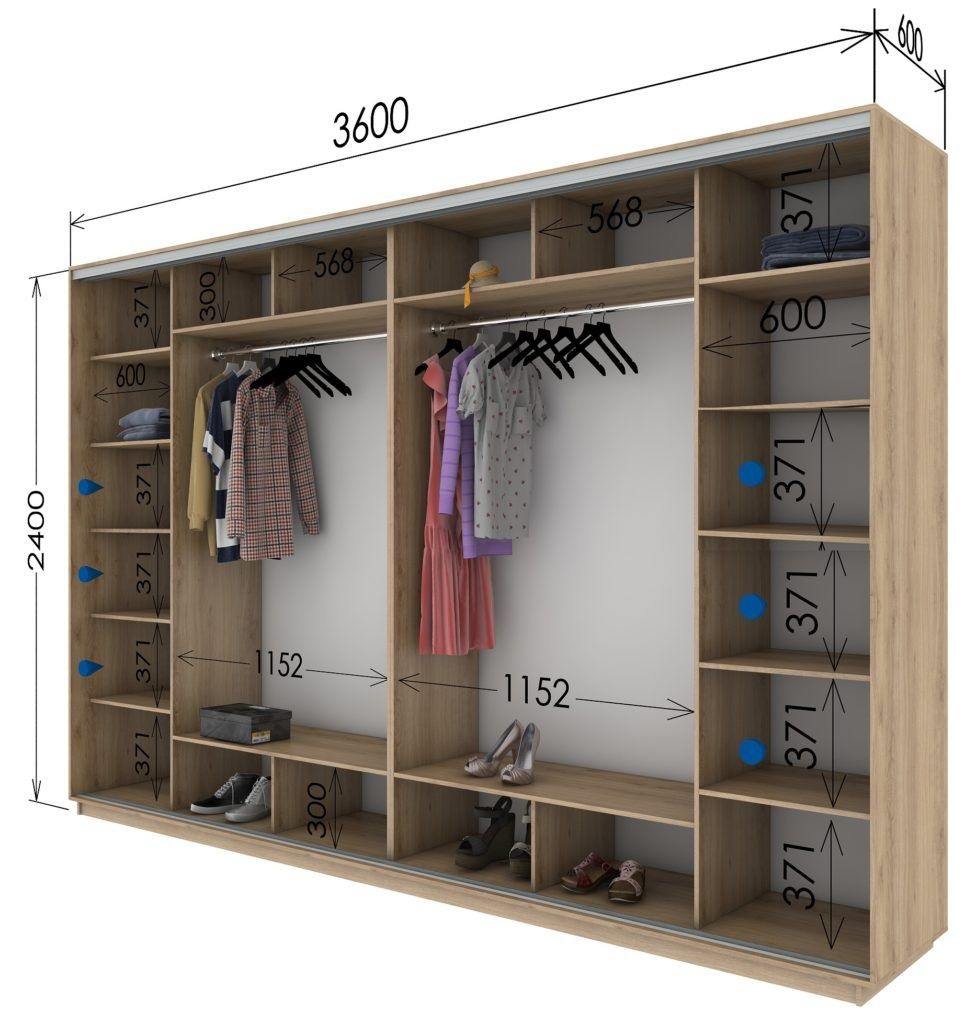
The number of sections, as a rule, should correspond to the number of leaves for easy access. The most convenient door width is from 60 to 90 cm, the height and depth of the structure are arbitrary. After the drawing is drawn up, you can order cutting of materials and accessories.
Materials used
Sliding wardrobes are usually made from one of four main types of material:
- Chipboard: the most popular and economical material available in different colors and textures. The preferred option is laminated chipboard (chipboard).
- MDF: durable and moisture resistant material with a perfectly flat surface. Recommended for the manufacture of cabinets with rounded elements.
- Veneer: Particleboard or MDF board covered with a thin layer of natural wood.
- Natural wood: the most expensive and luxurious option for luxury housing.

Note! When choosing a material, it is important to take into account the budget (their cost varies widely), operating conditions (weight of the intended content, room humidity) and the complexity of the design.
Sliding doors can be made from a wide variety of materials, the choice of which is due to aesthetic preferences and requirements for moisture resistance and strength of the doors. It can be mirrored or transparent glass, decoracryl, rattan, bamboo or other materials.

For elements of internal filling, fiberboard is often used (the walls of the boxes and dividers in them).

A complete set of fittings for the wardrobe includes the following:
- Profiles: can be aluminum or steel.Steel is stronger and more durable.
- Guides: they are single-lane, two-lane or three-lane (the number of lanes depends on the number of doors).
- Casters: The quality of the casters determines how smoothly the sliding mechanism will operate. They are symmetrical and asymmetrical.
- Stoppers: Installed on the bottom rail and secure the door.
- Seals: ensure a tight fit of the door to the side wall. They can be silicone or polyurethane.
Assembling the cabinet
It is important to ensure that all the necessary tools are available before assembling the cabinet. You will need a hammer, Phillips screwdriver, hex wrench, tape measure, level, utility knife or scissors, screwdriver, mallet, and an angle ruler. Consumables: confirms, nails, screws, plugs, rod holders and thrust bearings.

Important! The cabinet is installed only on a perfectly flat floor. If the floor surface is uneven, the leveling feet can be used to keep the bottom of the cabinet straight.
- Base / plinth assembly: with the help of confirmations, the bottom is attached to the strips, then the transverse plinth supports are attached.
- Body assembly (if any): side walls, wall panels and roof are installed one by one using confirmations. The back wall is fastened with self-tapping screws.
- Installation of internal elements: shelves and drawers are fastened with self-tapping screws and corners, rods - with rod holders.
- Installation of guides: first the upper rails are installed, then the lower ones. For the sliding mechanism to work properly, it is important to ensure that the guides are strictly in a straight line.
- Installation of doors: the rear and front sashes are installed alternately, then the stoppers. After installation, the door needs to be adjusted using the adjusting screws.
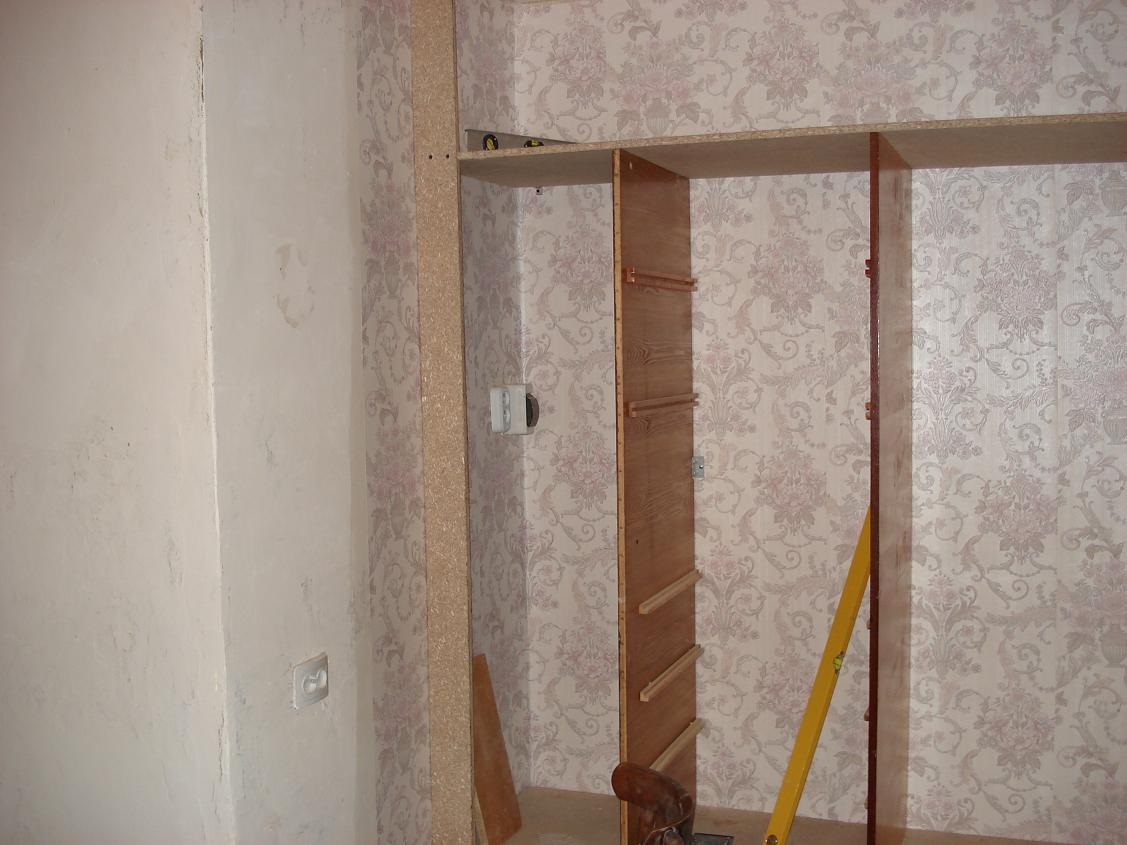
Note! In the absence of skills or difficulties at any stage of self-assembly of the wardrobe, it is recommended to seek help from a competent specialist.

Mirrored facade in wardrobes
When choosing a mirrored facade, the last step in door installation is the insertion of mirrors. To do this, a sealing gasket is put on the end of the mirror, after which it is inserted into the previously disassembled frame. Then the tie bolts are screwed onto the frame. The door is inserted first into the upper rail, then into the lower one, after which it is adjusted.

Filling the wardrobe
Inside, modern built-in wardrobes can be equipped with any variations of shelves, drawers, rods, hooks and other elements that maximize the use of usable storage space, convenience and aesthetics.

For the living room
A sliding wardrobe in a living room or in the hall of an apartment usually does not just function as a wardrobe - it becomes an aesthetic and functional component of the interior. In this case, the central section of the cabinet can be filled with shelves that form modules of different sizes, in one of which a TV or entertainment center will be installed, in others - paintings, photographs, figurines, a collection of books.

In this case, the closed doors will hide from prying eyes other items that are necessary in the room that are not decorative elements.
For bedroom
Maximum spaciousness is expected from the wardrobe in the bedroom, which means that it should be equipped with large shelves and drawers for storing bed linen and towels, in addition to longitudinal or transverse bars and shelves for clothes.

In addition, it is appropriate to equip the wardrobe for the bedroom with mesh baskets and additional elements, such as hangers for ties and trousers, drawers with dividers for belts, underwear and other small items of clothing and accessories.

For the hallway
The wardrobe in the hallway should accommodate outerwear and shoes, as well as have a convenient system for organizing items that are needed when leaving the house. In such a closet, it is advisable to install an open bottom shelf over the entire width, where it will be convenient to fold shoes.
Taking into account the fact that winter outerwear takes up a large volume, there should be a sufficiently wide and high (for long coats) module with a barbell and hooks in the closet. The closet also needs drawers and drawers, storage space for umbrellas, slippers, an organizer for keys, sunglasses, gloves and scarves.

For the nursery
A wardrobe for a nursery serves as a wardrobe for a child's clothes, as well as a storage area for toys or school supplies. It should have enough different compartments to accommodate all of this. In addition to the many boxes, you may need space to install boxes and containers for small toys, collectibles and other small items.
Open shelves can act as a mini-museum for children's creativity. Divided drawers can help your child learn to keep things tidy.
Important! It is not recommended to choose sliding wardrobes with a mirrored front for a nursery. Children are active, and during the game, the child can be severely injured if he falls on the fragile glass.

For kitchen
A large kitchen wardrobe can act as a universal storage unit that replaces other pieces of furniture, such as wall cupboards, pantry for food supplies, lower cabinets for storing large pots and pans. Thus, a kitchen compartment most often occupies the entire wall and is equipped with modules that provide space for the entire variety of kitchen utensils.

It is also possible to ergonomically integrate household appliances into the wardrobe - a washing machine, a dishwasher, a refrigerator. For this, the size of the modules must be calculated based on the dimensions of the equipment.
How to choose a quality wardrobe
In order for the cabinet to serve for a long time, it is necessary to give preference to high-quality wear-resistant materials and accessories. More reliable is the sliding mechanism, in which the roller moves along the monorail: it is protected from dust ingress and the roller jumping off the groove. The steel profile is much more durable than the aluminum one. Metal rollers are more reliable than plastic ones.
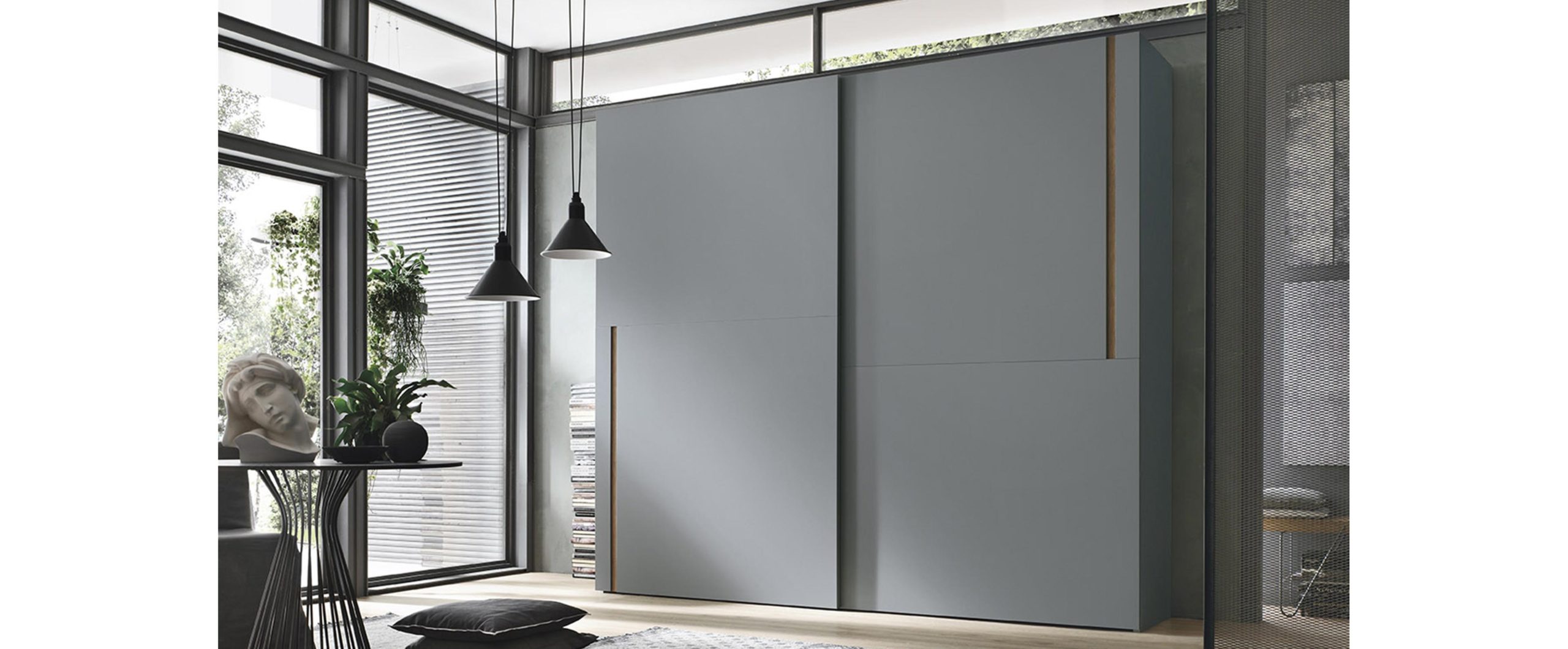
When making a cabinet to order, it is recommended to contact trusted companies and avoid unknown self-taught craftsmen who do not provide any guarantees.
The final choice of material for each component of the wardrobe, design, size and interior filling will depend on where the wardrobe will be located and how it will be used. Individual needs determine which quality parameters will be prioritized: strength of the case and shelves, reliability of fasteners, moisture resistance, safety for children and the elderly, or environmental friendliness.
Video: how to choose a wardrobe








